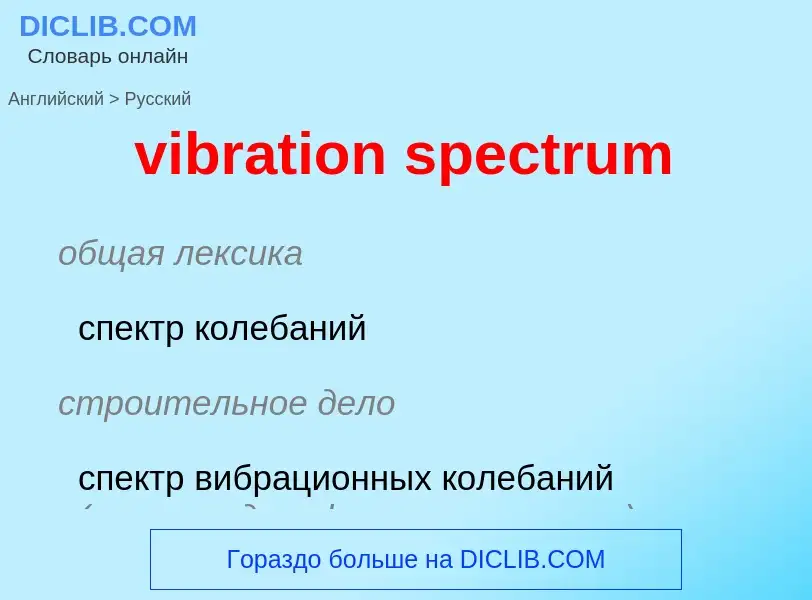Translation and analysis of words by ChatGPT artificial intelligence
On this page you can get a detailed analysis of a word or phrase, produced by the best artificial intelligence technology to date:
- how the word is used
- frequency of use
- it is used more often in oral or written speech
- word translation options
- usage examples (several phrases with translation)
- etymology
vibration spectrum - translation to russian
общая лексика
спектр колебаний
строительное дело
спектр вибрационных колебаний (амплитуда в функции частоты)
общая лексика
колебательный переход
Definition
Wikipedia
A molecular vibration is a periodic motion of the atoms of a molecule relative to each other, such that the center of mass of the molecule remains unchanged. The typical vibrational frequencies range from less than 1013 Hz to approximately 1014 Hz, corresponding to wavenumbers of approximately 300 to 3000 cm−1 and wavelengths of approximately 30 to 3 µm.
For a diatomic molecule A−B, the vibrational frequency in s−1 is given by , where k is the force constant in dyne/cm or erg/cm2 and μ is the reduced mass given by . The vibrational wavenumber in cm−1 is where c is the speed of light in cm/s.
Vibrations of polyatomic molecules are described in terms of normal modes, which are independent of each other, but each normal mode involves simultaneous vibrations of different parts of the molecule. In general, a non-linear molecule with N atoms has 3N – 6 normal modes of vibration, but a linear molecule has 3N – 5 modes, because rotation about the molecular axis cannot be observed. A diatomic molecule has one normal mode of vibration, since it can only stretch or compress the single bond.
A molecular vibration is excited when the molecule absorbs energy, ΔE, corresponding to the vibration's frequency, ν, according to the relation ΔE = hν, where h is Planck's constant. A fundamental vibration is evoked when one such quantum of energy is absorbed by the molecule in its ground state. When multiple quanta are absorbed, the first and possibly higher overtones are excited.
To a first approximation, the motion in a normal vibration can be described as a kind of simple harmonic motion. In this approximation, the vibrational energy is a quadratic function (parabola) with respect to the atomic displacements and the first overtone has twice the frequency of the fundamental. In reality, vibrations are anharmonic and the first overtone has a frequency that is slightly lower than twice that of the fundamental. Excitation of the higher overtones involves progressively less and less additional energy and eventually leads to dissociation of the molecule, because the potential energy of the molecule is more like a Morse potential or more accurately, a Morse/Long-range potential.
The vibrational states of a molecule can be probed in a variety of ways. The most direct way is through infrared spectroscopy, as vibrational transitions typically require an amount of energy that corresponds to the infrared region of the spectrum. Raman spectroscopy, which typically uses visible light, can also be used to measure vibration frequencies directly. The two techniques are complementary and comparison between the two can provide useful structural information such as in the case of the rule of mutual exclusion for centrosymmetric molecules.
Vibrational excitation can occur in conjunction with electronic excitation in the ultraviolet-visible region. The combined excitation is known as a vibronic transition, giving vibrational fine structure to electronic transitions, particularly for molecules in the gas state.
Simultaneous excitation of a vibration and rotations gives rise to vibration–rotation spectra.

![dissociation energy]] here, r<sub>0</sub> [[bond length]], U [[potential energy]]. Energy is expressed in [[wavenumber]]s. The hydrogen chloride molecule is attached to the coordinate system to show bond length changes on the curve. dissociation energy]] here, r<sub>0</sub> [[bond length]], U [[potential energy]]. Energy is expressed in [[wavenumber]]s. The hydrogen chloride molecule is attached to the coordinate system to show bond length changes on the curve.](https://commons.wikimedia.org/wiki/Special:FilePath/Anharmonic oscillator.gif?width=200)
